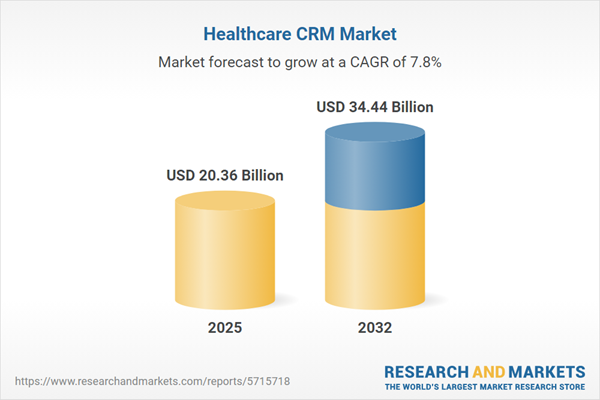Speak directly to the analyst to clarify any post sales queries you may have.
The healthcare CRM market is experiencing robust momentum as organizations prioritize patient-centered engagement and operational efficiency, driven by the integration of advanced digital platforms across the healthcare landscape.
Market Snapshot: Healthcare CRM Market Size and Growth
The healthcare customer relationship management (CRM) market grew from USD 18.92 billion in 2024 to USD 20.36 billion in 2025. Forecasts indicate a continued compound annual growth rate (CAGR) of 7.77%, reaching USD 34.44 billion by 2032. This growth reflects increasing digital transformation, rising patient expectations, and the ongoing evolution of regulatory and technology frameworks shaping healthcare operations. Enhanced integration across clinical and administrative domains positions CRM platforms as a vital tool for care coordination, patient engagement, and health system sustainability.
Scope & Segmentation
This report provides detailed coverage of the healthcare CRM market, examining vital segments and regional markets to deliver actionable insights for strategic decision-makers. Segments are analyzed to reveal drivers shaping both adoption and long-term investment.
- Component: Services (Consulting, Integration, Support); Software (Analytical CRM, Collaborative CRM, Operational CRM)
- Deployment Mode: Cloud (Hybrid, Private, Public); On-Premise (Customized, Standard)
- Application: Marketing Analytics (Campaign Management, Data Analytics); Patient Relationship Management (Acquisition, Engagement, Retention); Sales Force Automation (Lead, Order Management); Workforce Management (Performance Tracking, Scheduling)
- End User: Hospitals & Clinics (Clinics, Hospitals); Payors (Government Programs, Insurance Companies); Pharmaceutical Companies (Big Pharma, Biotech, Generics)
- Region: Americas (United States, Canada, Mexico, Brazil, Argentina, Chile, Colombia, Peru); Europe, Middle East & Africa (United Kingdom, Germany, France, Russia, Italy, Spain, Netherlands, Sweden, Poland, Switzerland, United Arab Emirates, Saudi Arabia, Qatar, Turkey, Israel, South Africa, Nigeria, Egypt, Kenya); Asia-Pacific (China, India, Japan, Australia, South Korea, Indonesia, Thailand, Malaysia, Singapore, Taiwan)
- Key Vendors: Veeva Systems, Salesforce, Microsoft, Oracle, Adobe, Zendesk, Freshworks, HubSpot
Key Takeaways for Senior Decision-Makers
- Seamless integration of healthcare CRM platforms into electronic health records, billing, and patient portals unlocks greater visibility and coordination across care teams and administrative functions.
- Real-time analytics and predictive tools within CRM systems enable personalized, proactive patient outreach while improving allocation of clinical and operational resources.
- API-driven cloud architectures and modular solutions support interoperability and accelerated deployment, helping providers adapt to evolving workflow and technology requirements.
- Tightening privacy regulations and enhanced security mandates drive robust data protection features in CRM offerings, meeting the compliance expectations of providers, payors, and pharmaceutical stakeholders.
- Regional market diversity—in terms of digital health maturity, regulatory climate, and funding levels—necessitates flexible deployment strategies and localized approaches to maximize CRM impact.
Tariff Impact on the Healthcare CRM Market
Newly introduced United States tariffs on imported hardware and software components are increasing cost pressures for CRM vendors deploying both on-premise and cloud-based solutions. Manufacturers and providers are adopting dual-sourcing and localized development strategies to offset infrastructure and licensing expenses. These regulatory changes are reshaping procurement models, encouraging investment in hybrid cloud architectures to maintain agility, protect data sovereignty, and support operational continuity in a shifting policy landscape.
Methodology & Data Sources
Findings are grounded in a multi-source approach, including structured interviews with industry leaders, review of peer-reviewed journals, regulatory filings, and vendor disclosures. Quantitative analysis from proprietary databases is triangulated with survey responses, delivering a comprehensive view of adoption trends and evolving client needs.
Why This Report Matters
- Equips business leaders with clear, granular market intelligence to inform technology investments and strategic planning.
- Offers a holistic assessment of segmentation, regulatory pressures, technology evolution, and competitive strategies across key regions.
- Supports informed decisions on CRM adoption, resource allocation, and vendor selection aligned to growth and compliance objectives.
Conclusion
Healthcare CRM continues to transform clinical and administrative engagement models, offering organizations the flexibility and insight needed to navigate regulatory changes and technological advancement. Strategic adoption and robust integration will define future success for healthcare leaders.
Additional Product Information:
- Purchase of this report includes 1 year online access with quarterly updates.
- This report can be updated on request. Please contact our Customer Experience team using the Ask a Question widget on our website.
Table of Contents
3. Executive Summary
4. Market Overview
7. Cumulative Impact of Artificial Intelligence 2025
Companies Mentioned
The companies profiled in this Healthcare CRM market report include:- Veeva Systems, Inc.
- Salesforce, Inc.
- Microsoft Corporation
- Oracle Corporation
- Adobe Inc.
- Zendesk, Inc.
- Freshworks Inc.
- HubSpot, Inc.
Table Information
| Report Attribute | Details |
|---|---|
| No. of Pages | 196 |
| Published | October 2025 |
| Forecast Period | 2025 - 2032 |
| Estimated Market Value ( USD | $ 20.36 Billion |
| Forecasted Market Value ( USD | $ 34.44 Billion |
| Compound Annual Growth Rate | 7.7% |
| Regions Covered | Global |
| No. of Companies Mentioned | 9 |









